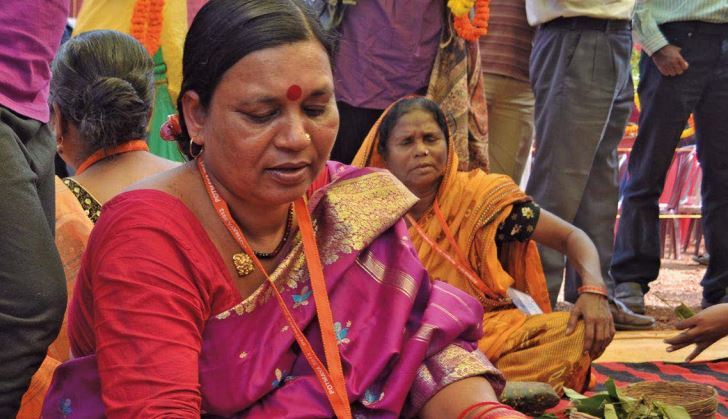
I am Swarna Chitrakar, and this is my story….
I belong to the village of Naya that is around 160 kms away from the city of Kolkata, in India. Our village has found a place on the cultural map of India because of its thriving tradition of Pata-chitra, or traditional scroll painting.
I went through the hardships of daily life like any other woman of my community. But I wanted to break free from social shackles and taboos, especially those that prevented painting and singing by women. I settled down at Naya with my husband and daughters and started painting Pata-chitra, encouraged by my father Amar Chitrakar and my uncle Dukhushyam Chitrakar.
Traditionally this art form was practiced by the menfolk. Men primarily painted and sang while the women helped in making colors from minerals, fruits, flowers, seeds and leaves. Women were not supposed to paint the pata themselves. All this has changed now.
Naya was once a poor village, but today it is an active settlement of around 60 families of Patua – the community of scroll painters, many of whom are women. The community is called Patua and all of them have their last name as Chitrakar, meaning painter. I belong to this community of painters. Naya is now a flourishing hub of Patachitra painting and a year round cultural and tourist destination.
At one point of time, this art form was dying as electronic media made inroads into the village community. It was tough to sell the paintings and our survival was difficult. A social enterprise www.banglanatak.com started working in our village to revive the tradition with support of the Eastern Zonal Cultural Centre in 2005. There were only around 20 painters and hardly anyone knew the songs. Veteran painters like Dukhushyam, Shyamsundar, Rani Chitrakar trained the young people on painting. Dukhushyam taught singing. Audiovisual CDs were published on our painting tradition. The lost art of the use of natural colour was revived.
In 2010, www.banglanatak.com organized POT Maya a three day fair in our village. They also set up a resource centre. The resource centre provided us much needed space to practice and showcase our art tradition. The fair and the resource centre created a new tourism culture. Tourists and visitors began to pour in with great interest and I could now have a direct communication and interaction with the collectors. POT Maya held in the second weekend of November celebrated its fourth edition in 2014. Our art has found appreciation among the local people as well as across the country and the globe. More and more artists and mainly women are now involved in Patachitra and there are more than 300 painters in our village. It has opened up a new world of freedom for womenfolk particularly. The women who had restricted mobility, are enjoying a new freedom and are travelling across the country. Patuas have now travelled to countries like France, Germany, the UK, Italy, China, The US, Australia and Japan.
Today Patachitra has become a vibrant folk media telling stories not only from epics and mythology but also on new contemporary subjects. We paint on themes like climate change, violence against women, human trafficking or events like 9/11 and tsunami. Collectors and buyers travel all the way to our village to see and buy our paintings. My village Naya has now become a most important tourist destination. The Department of Micro, Small, Medium Enterprise and Textiles is now supporting development of comprehensive infrastructure as our village has emerged as a successful Rural Craft Hub.
Today, I feel so happy to see children in the village taking up brush and color on weekend mornings anticipating visitors. I feel proud and happy that I am a part of this renewed culture.
